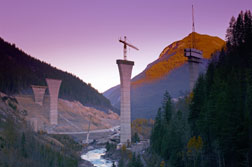 Parsons, � Rich Lasalle Parsons is part of a joint venture building a $118-million bridge across Kicking Horse Canyon in British Columbia.
|
When much of the nation turned on the news on Aug. 1 to discover that a bridge had collapsed in downtown Minneapolis, something that had been common knowledge in the transportation industry suddenly was highlighted for the entire nation: bridges and other U.S. infrastructure were crumbling because of inadequate funding for projects. The U.S. Chamber of Commerce recently reported that the funding shortfall will reach $1 trillion by 2015.
Some states are using tolls and private-sector concessions to find additional funds to rebuild and expand transportation infrastructure, but there has been a backlash. In Texas, for example, the state legislature passed a moratorium prohibiting the state from tapping private equity for two years.
The high visibility of the tragedy in Minneapolis could be a catalyst for change, some industry sources say. “I think the Minnesota collapse will make people more amenable to public-private partnerships,” says Ann Warner, vice president of government programs at Bechtel Infrastructure, Washington, D.C.
Doug Brigham, senior vice president of business development for the infrastructure unit of Washington Group International, Boise, Idaho, adds, “I think that this has gotten people’s attention. If the current press articles and comments by politicians are any indication, this theme of crumbling infrastructure has been around for many years and this may be the event that triggers additional funding.”
Despite the current funding issues, contractors are seeing a strong market, especially in the southern half of the country, says Brigham. California, Texas, Georgia, Florida, North Carolina and Virginia are the states that seem to have the deepest coffers, he says. The spending in these states is heavily bolstered by the use of toll bonds and private equity. After passing a law to allow for public-private partnerships, the Georgia Dept. of Transportation has aggressively pursued using this project delivery method, recently holding a pre-solicitation meeting on a $500-million project to build HOV or HOT lanes on Interstate 20 east of the city.
Some industry sources say that an increase in privatization and tolling could spur more opportunities for design-build. “About half of our design-build projects are public-private partnerships,” says Tom Barron, director of business development for Parsons, Pasadena, Calif. “The concessionaires and lenders need a firm commitment to price before they can close financing, virtually necessitating design-build.” But private developers are not the only ones interested in design-build, notes Barron, “More states are discovering that it is a more efficient delivery method,” he says.
The changes in the transportation market extend beyond financing and delivery. The transportation market is becoming more nationalized, as jobs increase in size and level of technical specialization, says Jerry Harder, president of PCL Civil Construction, Tampa, Fla. “Our technological specialization in areas such as segmental bridge work, is causing us to migrate towards new parts of the country such as Seattle,” says Harder.
Barron sees the traditional local and regional industry becoming more global. “The globalization of competition will change the face of who we team with, who we compete with and where we go in the world.” Whether globalization will lead to an increased market for American contractors or the influx of international contractors remains to be seen, he says. Parsons has made major forays into the closest foreign market, Canada. It is part of a joint venture building a $118-million, 1,328-ft bridge across the Kicking Horse Canyon in British Columbia as part of the Trans-Canada highway.
Preference for Tolling
While some are clamoring for raising the fuel tax after the Minnesota tragedy, the U.S. Dept. of Transportation is steadfast in its position that the tax not be increased. “The transition needs to begin as quickly as possible away from reliance on the gas tax,” says Tyler Duvall, the agency’s assistant secretary for transportation policy. “The more we rely on the gas tax at a federal level, the more we undermine our desire to reduce dependence on foreign oil. We can’t have dueling policies.”
DOT wants to shift to direct-usage based funding, says Duvall. The first project under the Interstate Construction Toll Pilot Program will extend I-73 80-miles from Myrtle Beach, S.C., to just south of Rockingham, N.C. While the project still must complete the environmental review phase, the primary funding source is certain. The pilot program is made possible in large part due to technological improvements in tolling, says Duvall. “The technology for charging travelers directly...
 Related Links:
Related Links: 
Post a comment to this article
Report Abusive Comment